
Gentiana is a genus of flowering plants belonging to the gentian family (Gentianaceae), the tribe Gentianeae, and the monophyletic subtribe Gentianinae. With about 400 species, it is considered a large genus. Gentians are notable for their mostly large trumpet-shaped flowers, which are often of an intense blue hue.

Gentiana acaulis, the stemless gentian, or trumpet gentian, is a species of flowering plant in the family Gentianaceae, native to central and southern Europe, from Spain east to the Balkans, growing especially in mountainous regions, such as the Alps and Pyrenees, at heights of 800–3,000 m (2,625–9,843 ft).

Gymnadenia conopsea, commonly known as the fragrant orchid or chalk fragrant orchid, is a herbaceous plant of the family Orchidaceae native to northern Europe.

Gentiana verna, the spring gentian, is a species of flowering plant in the family Gentianaceae, and one of its smallest members, normally only growing to a height of a few centimetres.
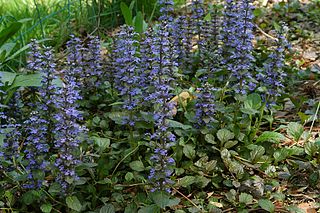
Ajuga reptans is commonly known as bugle, blue bugle, bugleherb, bugleweed, carpetweed, carpet bugleweed, and common bugle, and traditionally however less commonly as St. Lawrence plant. It is an herbaceous flowering plant in the mint family Lamiaceae, native to Europe. It is invasive in parts of North America. It is also a component of purple moor grass and rush pastures, a Biodiversity Action Plan habitat in the United Kingdom.

Silene dioica, known as red campion and red catchfly, is a herbaceous flowering plant in the family Caryophyllaceae, native to Europe and introduced to the Americas.
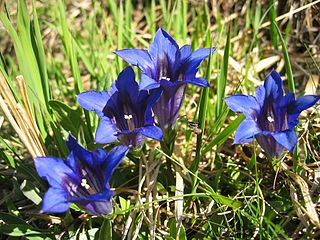
Gentiana clusii, commonly known as flower of the sweet-lady or Clusius' gentian, is a large-flowered, short-stemmed gentian, native to Europe. It is named after Carolus Clusius, one of the earliest botanists to study alpine flora.

Gentianella is a plant genus in the gentian family (Gentianaceae). Plants of this genus are known commonly as dwarf gentians.
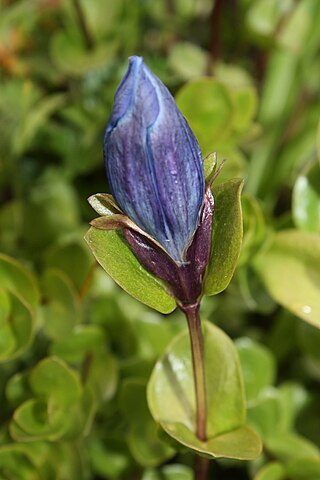
The herbaceous perennial plant Gentiana calycosa is a species of gentian known by the common names Rainier pleated gentian and mountain bog gentian.
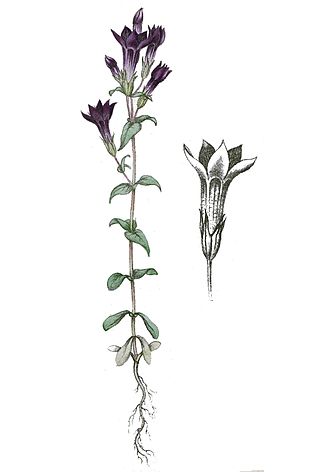
Gentianella amarella, the autumn gentian, autumn dwarf gentian, or autumn felwort, is a short biennial plant flowering plant in the gentian family, Gentianaceae. It is found throughout Northern Europe, the western and northern United States, and Canada.

Gentiana setigera is a species of gentian known by the common name Mendocino gentian. It is native to southern Oregon and northern California where it grows in wet places in the California Coast Ranges. It grows in serpentine soils.
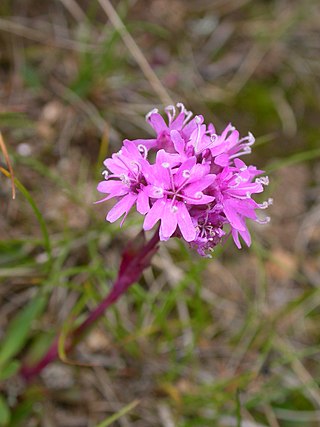
Silene suecica is a species of plant in the family Caryophyllaceae. Its common name is red Alpine catchfly and its natural habitat is the mountains of Norway and Sweden but it is sometimes found near the coasts and it is also found in the Alps and the Pyrenees, Greenland and North America.

Hippocrepis emerus, the scorpion senna, is a species of perennial plant belonging to the genus Hippocrepis in the family Fabaceae.

Gentiana cruciata, the star gentian or cross gentian, is a herbaceous perennial flowering plant in the Gentianaceae family.

Gentiana glauca is a species of flowering plant in the gentian family known by the common names pale gentian and glaucous gentian. It is native to eastern Asia and northwestern North America from Alaska to the Northwest Territories to Washington and Montana.

Gentiana bavarica, the Bavarian gentian, is a herbaceous perennial species of flowering plant in the Gentian family Gentianaceae.

Gentiana pannonica, the Hungarian gentian or brown gentian, is a species of flowering plant of the genus Gentiana in the family of Gentianaceae.

Antirrhinum hispanicum, the Spanish snapdragon, is a species of flowering plant belonging to the genus Antirrhinum that is native to southeastern Spain.

Gentiana froelichii, commonly known as the Karawanken gentian, is an endemic hemicryptophyte and perennial plant species in the family Gentianaceae, which occurs in southeastern Alps. It can be found in Austria and Slovenia, with a few reported occurrences happening in Italy.
Cyananthus formusus is a species of perennial flowering plant in the family Campanulaceae. It is native to grassy slopes and forests of northwest Yunnan in China. In Mandarin the species is known as 美丽蓝钟花. Originally described by Ludwig Diels in 1912 in the Notes of the Royal Botanical Garden Edinburgh, the species is a small, blue-flowered plant suitable for Alpine gardens.




















